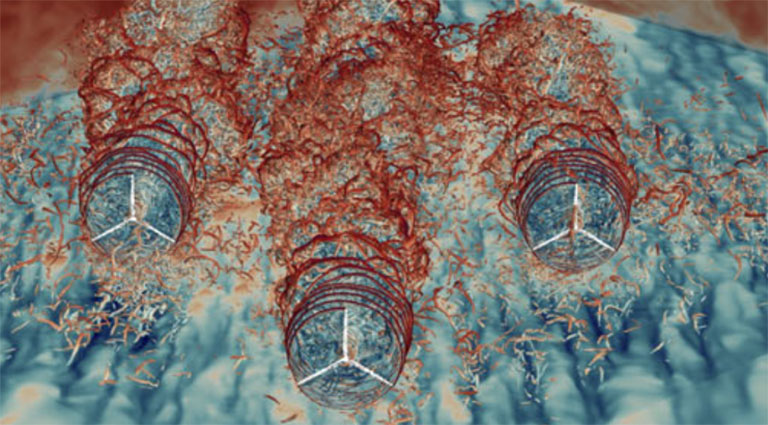Applied Mathematics
NREL's research in applied mathematics develops computational methods for high-fidelity simulations and uses high-performance computing and data-driven models to enable the design and scale-up of energy systems.

The ExaWind project simulates large wind farm interactions, such as the one shown above—NREL’s 5-MW turbines in a stable atmospheric boundary layer. Image by Nicholas Brunhart-Lupo and Ashesh Sharma, NREL
NREL applied mathematics research focuses on developing or optimizing new or improved methods and modeling paradigms to meet energy challenges, modeling applications in the real world, and releasing our software as open source.
NREL researchers combine their knowledge with advanced computing resources, utilizing analytical and numerical methods and regularly collaborating with domain experts and researchers—as well as conducting their own computational research—to apply the tools and techniques we develop as real-world solutions to energy questions.
Applied mathematicians improve NREL's ability to address research challenges by bringing new and advanced mathematical techniques to scientific, technical, and analysis problems. Mathematics are required to describe, model, simulate, solve, explore, and optimize complex systems, whether those systems are interacting atoms, systems of chemical reactions, or engineered systems describing the electric grid. Capabilities in this area include:
- Computational fluid dynamics (CFD): Simulations of gases and liquids to enable analysis and inform design of energy technologies such as wind farms, fuel cells, and biofuels.
- Non-continuum methods: Mathematics required to describe, model, simulate, solve, explore, and optimize complex systems of discrete components, whether those systems are interacting atoms or engineered systems such as transportation networks.
- Surrogate modeling and uncertainty quantification: Formulation and implementation of simplified models of complex systems enable advanced optimization and control techniques that balance accuracy of representation with computational cost. Mathematics to quantify uncertainty are used to enable decision-making, e.g., to reliably deploy intermittent renewable energy resources.
Computational Fluid Dynamics
NREL's CFD research focuses on energy efficiency opportunities and improving energy technologies. Often, we leverage adaptive mesh refinement via techniques such as the AMReX framework, an open-source software library for solving equations with local grid refinement to enhance resolution (accuracy) at affordable computational cost. AMReX is designed to be efficient on high-performance computing systems composed of diverse architectures, which enables its use on cutting-edge and upcoming supercomputers.
Incompressible and low-Mach-number flows are solved using low-speed solvers.
ExaWind Software Suite
AmrWind - AMReX-based solver for atmospheric flows
Mesoflow
AMReX-based code for catalytic upgrading and pyrolysis
Adaptive Mesh and Algorithm Refinement
AMAR: adaptive mesh and algorithm refinement
Pele Software Suite
PeleLMeX—low Mach solver for turbulent reacting flows
High-Mach-number flows are addressed using compressible flow solvers.
Pele Software Suite
PeleC – compressible turbulent reacting flows
Energy Research and Forecasting
AMReX-based mesoscale atmospheric wind code
Non-Continuum Methods
NREL's research in discrete simulation advances techniques for the transport of dispersed phases, solid mechanics, and particle-based models for fluid dynamics.
MARBLES: Multi-Scale Adaptively Refined Boltzmann LatticE Solver (GitHub)
An open-source CFD package that efficiently simulates fluid flow around intricate
geometries—including moving or porous surfaces—without the need for a body-conforming
mesh
NREL's research in Monte Carlo simulations includes techniques for crystal growth and fluid dynamics.
Adaptive Mesh and Algorithm Refinement
SPPARKS – KMC code for material growth
BDEM: Discrete-Element Simulator for High-Solids Granular Flows (GitHub)
A discrete element method-based simulation tool for modeling high-solids granular
flows that include polydispersity, heat transfer, moving boundaries, and chemistry.
The solver provides facilities for simulating spherical/nonspherical particles with
modified contact and friction models in complex dynamic geometries defined using level-sets
or triangulated files.
SPADES: Scalable Parallel Discrete Events Solvers
Event-driven simulations of complex systems
Biomass Feedstock Conversion Interface Handling Computational Models
Simulating the handling and flowability of organic biomass feedstock in coupled feed
systems
Exagoop (GitHub)
An open-source material point method solver that efficiently simulates the dynamics
of highly deformable continuum phases.
Biomass Feedstock Conversion Interface Handling Computational Models
Simulating the handling and flowability of organic biomass feedstock in coupled feed
systems
Surrogate Modeling, Statistics, and Uncertainty Quantification
NREL researchers leverage high- and multi-fidelity data from simulations and experiments to develop computationally efficient methods for control and optimization of complex systems. Mathematics to quantify uncertainty are used to enable decision-making and numerics that take the uncertainty of variable renewable resources into account.
Pipeline of simulation capabilities—including simulation of pretreatment, enzymatic hydrolysis, fermentation processes—for the conversion of biomass into second-generation biofuels
Simulates wind loading and stability in solar-tracking PV systems
Framework for performing multi-fidelity modeling
High-fidelity simulations of biofuels used in aircraft engines to affect performance, fuel economy, and reliability
Contact
Share

